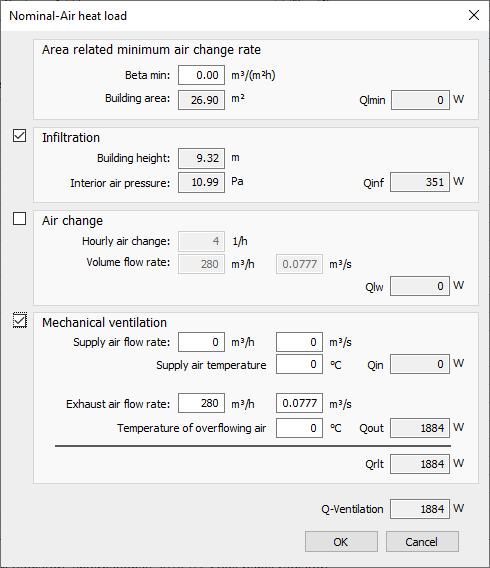Details on Nominal-Air Heat Load
Information on the Nominal-Air heat load dialog at room level.
You are here:

Area related minimum air change rate
Beta min: The minimum volume flow for the minimum hygienic air exchange. The standard for residential buildings is proposed at 3 m3/(m2h) and may be modified by the user based on further requirements. If a room is interior and does not contain a window, this value is set to zero and the Area related minimum air exchange and Infiltration sections are deactivated.
Building area: The area of the room, taken from the room data.
Qlmin: Ventilation heat loss due to the area related minimum air change.
Infiltration
Ventilation heat losses due to infiltration depend on the pressure difference between room air and outside air. The pressure differences are calculated depending on the location, wind velocity and the height of the room in the building.
Building height: Height of the building, taken from the general building data.
Interior air pressure: Calculated and displayed for information here. If you have activated the simplified infiltration calculation at the project level, the interior air pressure of the room is not used and is set to zero.
Qinf Ventilation heat loss due to infiltration. The ventilation heat losses are determined, among other things, depending on the specific permeability, the air resistance and the joint proportion of the wall area.
Air change
Air change cannot be activated simultaneously with mechanical ventilation.
Hourly air change: Agreed number of air changes per hour.
Volume flow rate: Air volume flow rate per hour or per second, is determined from the number of hourly air changes and the room air volume.
Qlw: Ventilation heat loss due to manual air changes.
Mechanical ventilation
The hygienic minimum air exchange can also be ensured by means of an air handling unit. If the exhaust air flow rate is higher than the supply air flow rate, an additional air volume flow rate by infiltration is added to the room.
Supply air flow rate: Scheduled supply air flow rate per hour or per second.
Supply air temperature: Temperature of the preconditioned supply air volume flow rate (e.g. by heat recovery or air heater). If the supply air temperature is lower than the room air temperature, a heat load is charged. Heat gain through the supply air is not supported.
Qin: Ventilation heat loss due to the supply air volume flow rate of the air handling unit.
Extract air flow rate: Scheduled exhaust air volume flow rate per hour or per second.
Temperature of overflowing Ambient air: Temperature of the mechanical infiltration volume flow rate, which is brought in among other things via overflow openings from other rooms. If this temperature is lower than the room air temperature, a heat load is charged.
Qout: Ventilation heat loss due to the exhaust air volume flow rate of the air handling unit.
Qrlt: Sum of the ventilation heat loss of the air handling unit.
Q-Ventilation: Ventilation heat loss used for further calculation. The results of the area-related minimum air change rate and the other activated ventilation types (infiltration with air change or mechanical ventilation) are compared and the highest value is entered here.